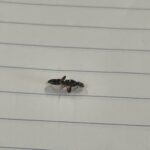Sample information |
|
| Picture |






|
|---|---|
| Location | |
| Collection date | 09/28/2024 |
| Captive / Cultivated? | Wild-caught |
| Group | Edmund Burke School |
| Observations | caught in a public park, temperature of about 70 degrees Fahrenheit, terrestrial habitat.
Two big grey wings, two antennae, appears to be a moth. |
| Putative identification | Arthropoda Insecta Lepidoptera Hesperiidae Atalopedes Atalopedes campestris |
Methods |
|
| Extraction kit | DNeasy (Qiagen) |
| DNA extraction location | Whole arthropod |
| Single or Duplex PCR | Single Reaction |
| Gel electrophoresis system | MiniOne |
| Buffer | TBE |
| DNA stain | GelGreen |
| Gel images |


|
| Protocol notes | DNA Extraction: I made sure to crush the arthropod very well, but there were large chunks of exoskeleton that were difficult to break up. As a result, the sample had to be spun 1-2 extra times in the centrifuge for the steps using the filter.
Gel Electrophoresis, arthropod CO1: 1 – DNA ladder 2 – A4 DNA 3 – A5 DNA 4- A6 DNA 5 – Arthropod positive control 6 – Arthropod negative control 7 – water Analysis: all controls showed expected bands, and the sample showed an arthropod CO1 band. Gel electrophoresis, Wolbachia: 1 – DNA ladder 2 – A4 DNA 3 – A5 DNA (lascoria ambigualis) 4- A6 DNA 5 – Wolbachia positive control 6 – wolbachia negative control 7 – water Analysis: all controls showed expected bands, and the sample did not show a wolbachia band.
|
Results |
|
| Wolbachia presence | No |
| Confidence level | High |
| Explanation of confidence level | All of my controls worked as expected. I did not have any problems |
| Wolbachia 16S sequence | |
| Arthropod COI sequence |
|
| Summary | The Atalopedes campestris was found to be negative for Wolbachia. |
 European Paper Wasp
European Paper Wasp Woodworm Ant
Woodworm Ant